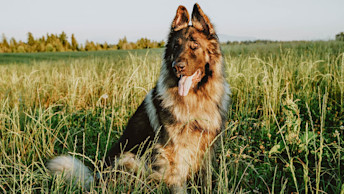September 7, 2021
Grain Free or Grain Inclusive?

Grain-free diets are commonplace in the pet food aisle. There are several reasons for this category of pet foods, including the belief that grains are harmful for pets and that grain-free diets are more appropriate for dogs and cats from an evolutionary perspective.
What are grains good for?
Grains are an important source of complex carbohydrates, which are more slowly digested compared to simple carbohydrates. Although carbohydrates are not considered essential nutrients in the diets of dogs and cats and are often mislabeled as “fillers,” they do play a critical role in your pet’s body. In particular, carbohydrates provide a highly digestible, readily available energy source. Foods which are rich in complex carbohydrates are also an important source of essential nutrients. The shape, texture and density of kibble and wet food also depend on the carbohydrate (starch) content of the food. This is important, as mouthfeel and the structure of food help to determine palatability.
Can dogs and cats use carbohydrates from grains?
Yes! Recent genetic research suggests that one of the important steps in the domestication of dogs was their adaptation to a diet higher in carbohydrates relative to the diet of carnivorous wolves. Although carbohydrates are not considered essential for cats, research suggests that moderate amounts may actually be beneficial in promoting insulin sensitivity. Another benefit of dietary carbohydrates is that they, along with fat, are body’s preferred source of energy; using protein as an energy source can be inefficient and expensive, both metabolically and environmentally.
Some of the grains commonly found in pet foods
- Barley
- Corn
- Rice
- Oats
- Millet
Whole grains include all parts of the grain, while refined grains have the nutrient-rich germ and bran layers removed. Whole grains support digestive health since they are not only an excellent source of complex carbohydrates but are also rich in fibre. Dietary fibre is a unique type of carbohydrate that cannot be digested by your pet’s digestive enzymes, but nonetheless provides many benefits. For example, oats and barley contain a special type of fibre called beta-glucan, which has been shown in numerous human studies to fight heart disease and diabetes. Beta-glucan may also be beneficial in pet foods to help support a healthy weight.
My pet is allergic to grains, what are my options?
Some pets may have intolerances to one or more specific grains, but it might not be necessary to eliminate all grains. Grain-free does not mean carbohydrate-free, as complex carbohydrates are found in many non-grain ingredients such as peas, lentils, chickpeas, tapioca, potatoes, and sweet potatoes.
Gluten-free diets are necessary for humans diagnosed with celiac disease or nonceliac gluten sensitivity, but this is not a common problem in pets and most tolerate gluten without any difficulty. The exception is some Irish Setters with inherited gluten sensitivity.
Many grain-free pet foods are higher in protein than their grain-inclusive counterparts. Since all foods contain a balance of carbohydrates, fat, and protein, decreasing the amount of carbohydrate in a food will increase the fat and/or protein content. While extra protein is typically not a problem for most healthy pets, it can be problematic in certain medical conditions such as later stages of kidney disease, or pancreatitis in the case of increased fat.
What are some of the benefits of grain-free carbohydrate sources?
Pulse ingredients such as lentils, peas and chickpeas are an excellent source of complex carbohydrates, fibre, vitamins, and minerals, and provide most of the essential amino acids required by dogs and cats. Uniquely, peas provide an added environmental benefit in that they are used as a tool in sustainable agriculture to add nitrogen back into the soil.
Potatoes are a rich source of essential vitamins and minerals, particularly vitamin C and potassium. Cooked potatoes are also rich in prebiotic fibre which can support a healthy gut microbiome and good quality stools.

Tapioca provides a novel source of energy and does not contain protein, so it is not typically considered a potential allergen or source of food sensitivity. This is especially important in limited ingredient diets that are designed for pets with sensitivities.
So, what’s the right choice?
Overall, there is no ‘right’ choice - only the best choice for you and your beloved cat or dog. Both grain free and grain ingredients offer many health benefits and can be used to make a safe, healthy, complete, and balanced diet. Below is a small overview of some popular grain and non-grain ingredients along with their benefits.
Benefits of Grain Ingredients
Ingredient | Nutrients | Fibre Type | Highlights |
|---|---|---|---|
Oats | Vitamin B1, zinc, magnesium | Soluble & insoluble, prebiotic | Beta-glucan, gluten-free |
Barley | Vitamin B1, B2, manganese | Soluble & insoluble, prebiotic | Beta-glucan, ancient grain |
Millet | Magnesium | Soluble & insoluble, prebiotic | Ancient grain, gluten-free |
Benefits of Non-Grain Ingredients
Ingredient | Nutrients | Fibre Type | Highlights |
|---|---|---|---|
Peas | Amino acids, vitamin E, zinc | Insoluble, soluble & prebiotic | Good source of polyphenols (antioxidants), gluten-free |
Lentils | Amino acids, manganese, zinc | Insoluble, soluble & prebiotic | Good source of polyphenols (antioxidants), gluten-free |
Potatoes | Iron, vitamin B1, B3, magnesium, potassium | Insoluble, soluble & prebiotic | Cooked potatoes a good source of prebiotic fibre, gluten free |
This article originally appeared on Multibriefs.com.
This article was originally published April 8, 2016. Refreshed September 2021.



